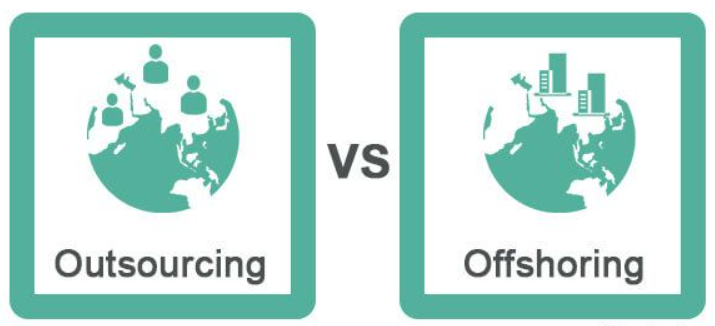Offshoring and Outsourcing staffing model has advantages if implemented strategically at the right time. This blog will explain to you “How to make the right choice between outsourcing and offshoring?” which includes:
- Functional Differences / Operational Differences
- Pricing Model and Cost Differences
- Outcome-driven differences
- Tips to choose the right staffing model at the right time
People often debate on “offshoring v/s outsourcing: which is the right staffing model?” It’s a decision where the organization strategizes its staffing operation model: whether to onboard for only work or relocate candidates offshore.
- Deloitte’s latest Global Outsourcing Survey states that 80% of executives plan to maintain third-party outsourcing for talent agility and measurable outcomes.
- In the meantime, enterprises are expanding offshoring via global capability centers and vendor networks. India alone hosts 1800+ GCSs, which generated $64.6 billion in GCC revenue in 2024.
- Moreover, McKinskey & Company shared that offshoring has a history of delivering -45-55% cost-based reductions after overheads.
There was an increase in both staffing models based on numerous factors. This guide will break down the brief differentiation between outsourcing vs offshoring, which helps other organizations to take the right strategic decision for their operational efficiency.

Outsourcing vs Offshoring – Definition Difference
Outsourcing
Contracting a third-party provider to handle a function or process under an agreed scope, SLA, and price model. Delivery location can be onshore, nearshore, or offshore. You trade direct control for speed, flexibility, and outcome guarantees. Common for IT services, support, payroll, finance ops, and specialized projects.
Offshoring
Moving work to a different country to access cost advantages and talent depth. Execution can be in-house (captive/GCC/ODC) or through a vendor (offshore partner). You gain structural cost savings and long-term capacity but take on compliance, culture, and management responsibilities across borders.

Difference Between Outsourcing and Offshoring
Compare outsourcing and offshoring across the dimensions that matter: control, cost, IP/security, compliance, and ramp time. This quick guide helps enterprises decide when to outsource, offshore, or combine both.
| Dimensions | Outsourcing | Offshoring |
|---|---|---|
| Ownership of the team | Vendor-owned; governed by contract | Captive: you own; Vendor offshore: shared control |
| Employment relationship | Onshore, nearshore, or offshore (flexible) | Always cross-border (offshore) |
| Location | Onshore, nearshore, or offshore (flexible) | Always cross-border (offshore) |
| Primary goal | Speed, flexibility, outcome accountability | Structural cost leverage, deep talent pools, and long-term capacity |
| Engagement model | T&M, managed service, fixed outcome with SLAs/KPIs | Captive/GCC, ODC, BOT, or offshore vendor |
| Cost structure | Opex (rate cards/managed outcomes) | Labor-arbitrage + scale; Capex if building captive |
| Compliance & legal | Depends on vendor posture + your oversight | Added jurisdictional risk (labor, tax, privacy); potential PE exposure |
| Talent strategy | On-demand specialization; elastic capacity | Build sustained capability; leadership onshore, delivery offshore |
| Risk mitigations | Multi-vendor, knowledge base, exit plan, architecture guardrails | EOR/PEO interim, strong security/compliance, local counsel, playbooks |
Benefits of Outsourcing
- Speed to value – Spin up expert teams quickly with ready tooling and SLAs/KPIs; ideal for pilots or surge demand.
- Access to specialized skills – Tap niche capabilities (AI/ML, cybersecurity, DevOps) without long hiring cycles or training overhead.
- Elastic capacity – Scale up/down by project or season without adding fixed headcount; predictable Open via rate cards/managed outcomes.
- Risk transfer – Shift delivery risk to a vendor with contractual governance (SLAs, penalties/bonuses, audits) and defined outcomes.
- Focus on core – Keep internal teams on strategy and IP-heavy work while partners handle non-core functions efficiently.
Benefits of Offshoring
- Lower structural cost – Benefit from labor-arbitrage and scale efficiencies across mature offshore hubs (India, Philippines, LATAM, Europe).
- Deep talent pools – Build sustainable capability in engineering, support, finance ops, and analytics with stable pipelines.
- Follow-the-sun coverage – Achieve 24×7 operations and faster cycle times through time-zone diversification.
- Greater control (captive/GCC option) – Own processes, culture, and IP end-to-end via a captive/ODC, or blend with vendor pods.
- Scalable foundation – Create multi-year capacity for core/adjacent functions, with governance for security, data residency, and compliance.
When To Choose Outsourcing?
- Launch fast: Meet surge demand or pilot a function with ready teams, tooling, and SLAs.
- Fill skill gaps: Access niche expertise (AI, security, CX) without long hiring cycles.
- Stay flexible: Scale up or down by project with predictable Opex and outcome-based pricing.
- Reduce delivery risk: Transfer execution risk to a vendor with KPIs, audits, and penalties/bonuses.
When To Choose Offshore?
- Cut structural costs: Build durable capacity in proven hubs to lower the total cost of operations.
- Secure long-term talent: Establish stable, high-skill teams for core or adjacent functions.
- Run 24×7: Use time-zone diversification to accelerate release cycles and customer support.
- Increase control: Stand up a captive/GCC or blended ODC to own processes, culture, and IP.
Challenges with Outsourcing
- Lose day-to-day control: Depend on vendor processes; manage via SLAs/KPIs and audits.
- Risk vendor lock-in: Proprietary tooling and knowledge concentration make switching costly.
- Face black-box delivery: Limited transparency into team composition, QA, and handoffs.
- Protect IP and data: Enforce airtight MSAs/SOWs, DLP, and access controls.
- Sync culture and context: Align domain understanding to avoid rework and expectation gaps.
Challenges with Offshoring
- Navigate compliance complexity: Handle cross-border labor, tax, data residency, and potential PE exposure.
- Manage time-zone friction: Plan overlap hours and robust async rituals to prevent delays.
- Carry setup overhead: Captive/GCC models need entity formation, policies, and leadership bandwidth.
- Guard IP across borders: Implement strict security, NDA/IP assignment, and monitoring.
- Bridge cultural/communication gaps: Invest in playbooks, onboarding, and clear operating cadence.

Cost Differentiation: Outsourcing vs Offshoring
- Pricing model:
- Outsourcing = all-in Opex (vendor rate covers salary, overhead, tools, margin).
- Offshoring = structural cost play (lower local salaries) plus either vendor margin or your own captive costs.
- Upfront vs ongoing:
- Outsourcing has minimal setup; you pay a predictable hourly/managed rate
- Offshoring (captive/GCC) needs entity setup, compliance, and leadership bandwidth—then delivers a lower steady-state run rate.
- Management Overhead:
- Outsourcing shifts day-to-day to the vendor (governed by SLAs/KPIs).
- Offshoring requires more internal management (hiring, HR, QA, security) unless you use an offshore vendor variant.
- Hidden costs to watch: Knowledge transfer, shadow IT/tooling, seat/licenses, transition/exit, bench, cross-border compliance (for offshoring), and change management.
| Model | Cost Stack | Indicative Range |
|---|---|---|
| Outsourcing (Managed Service, any location) | Vendor blended rate (salary + overhead + tools + margin) | $5,600–$7,200 (≈ $35–$45/hour × 160 hours) |
| Offshoring via Vendor (e.g., India/Philippines) | Lower regional salary + vendor overhead + margin | $3,800–$5,200 |
| Offshoring – Captive/GCC (e.g., India) | Local salary + benefits (~15–25%) + facilities/admin + management overhead + amortized setup | ≈ $3,200–$3,400 (after setup amortization) |
Which Model Should You Choose – Outsourcing or Offshoring?
If the decision is outsourcing vs offshoring, start with first principles: outsourcing optimizes who delivers outcomes; offshoring optimizes where work lives. For fast ramp, clear SLAs, and elastic Opex, outsourcing wins. For structural cost efficiency, deep talent pools, and multi-year capacity, offshoring (captive GCC/ODC or vendor) pays back. Many enterprises blend models, adding nearshoring for time-zone overlap, EOR/PEO to hire compliantly before entity setup, or BOT to transition a vendor-run team into a captive.
Your final call should weigh control, compliance, IP/security, time-to-value, total cost of ownership, and other aspects. If you need a pragmatic path, start with a small outsource agency, prove value, then expand offshore capacity where it’s core needed. Ready to map the difference between outsourcing and offshoring to your roadmap? Use the decision framework above or speak with a staff augmentation service to align with the right and strategic model.

